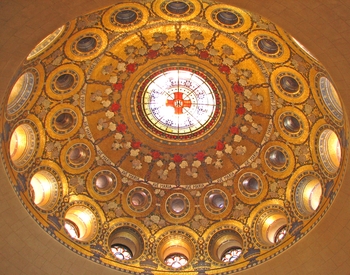|
INTRODUCTION
Drugs,
violence, magic, promiscuity, are all ways of trying to smash through the
complacency and frustration of everyday life. We can become trapped in a
conventional existence, and our deep pain tells us that something is very wrong.
But what really traps us is ourselves, our own limitations, our own self-defined
image. Attempts to escape often make things worse. They soon turn into other,
narrower traps.
The only
real escape is self-transformation. What we need is a spiritual path that
leads beyond ourselves. All religions offer such a path, a path of
transformation, although by its nature it is often hard to discern. (The film The
Matrix was a metaphor for this.) Every religion has its own teachers, gurus,
guides, to help us find the path and to walk it.
The
distinctive claim of Catholic Christianity is that God himself became man, died
and rose from the grave, and that his continued living presence is accessible
through prayer and the sacraments of the Church.
In this section we want to help you explore this tradition in order to
find resources that may help you in your search for the true, the good, and the
beautiful.
|
Go HERE
for stuff on Christian beliefs and how to understand them
Go HERE
for stuff on the spiritual life, prayer and meditation -- the “Way of Jesus”
Go HERE
for stuff on Catholic liturgy (the public worship of the Church)
All
Things Made New (Editors blog on spirituality)
|
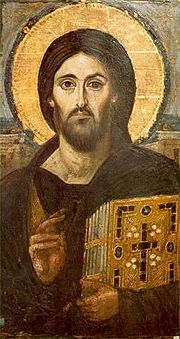
|
1.
CHRISTIAN BELIEFS
|
If you
want to understand the Catholic faith, try to read and study the Catechism of the Catholic Church. That is really the place to
start. Nothing that is said here is intended to substitute for reading the Catechism.
There are many printed editions available, and it is online at the Vatican
Archives.
It is
also available in a different format at www.scborromeo.org/ccc.htm.
If you have time, you may also wish to study it in more depth on a guided
programme, either through your parish or with the Maryvale
Institute in
Birmingham
or the Ogilvie Institute
in
Scotland
.
|
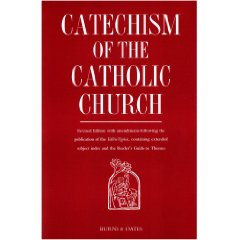
|
Does
God exist?
If you are not so sure,
click here.
Conversation
with a Skeptic
Put
any questions you may have
to our online
community
Questions
and answers
Here are
some questions we have received in the past, and our answers to them:
Section
One: Miscellaneous
and Moral
Section
Two: The
Spiritual Life
Section
Three: Scripture
Section
Four: Church and
Tradition
Catholic
Social Teaching
Go HERE
Theology
of the Body
Go HERE
Christianity and the New Age
Go
HERE
Some
useful articles
Why
go to confession? Reconciliation and the Beauty of God, by Bruno Forte
12
Claims Every Catholic Should be Able to Answer, by Deal Hudson
5
Myths about 7 Books, by Mark Shea
What
is Faith?
The
Existence of God
The
Problem of Evil
The
Problem of Hell
A
New Approach to Sin
Christianity
and Other Religions
How
can Catholicism be true when Catholics are so dead?
How
do we defend the Church to those who have been burned by it?
How
to Make Sense of Catholic Teachings on Sex
What
is 'sin' and why did Jesus die on the Cross?
Catholic
Answers to Evangelical Questions
Marriage and the Prophylactic Use of Condoms by Luke Gormally
Contraception by
Stratford Caldecott
There
are many more articles here, on a site developed by Scott Hahn:
http://www.salvationhistory.com/library/apologetics/Topics.cfm?PID=1197
The following site is also useful for questions and answers:
2. THE
WAY OF JESUS
|
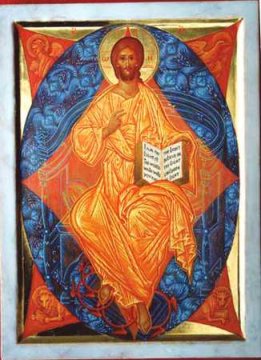
image courtesy of
www.sanctiangeli.org |
Jesus
does not simply know the Way; he himself, in his own person, is the
Way. “I am the way and the truth and the life,” he tells his disciples (John
14:6).
How do
we follow Jesus? In the first place, we follow him by listening devoutly and
attentively to the voice of the Holy Spirit, the Spirit of Christ and his
Father. The Spirit is speaking to us all the time, especially through not
exclusively in the Church and in the Christian tradition.
What
is prayer? At
its most basic level, prayer is a way of paying attention to the possibility of
God, or even just of our need for God.
Even if we don’t feel we know that God
exists, even if we can’t really say we have any faith at all, we can still pray. We can still reach out towards the
source of our life, reaching towards the mystery that will catch up to us when
we die.
|
In other words, we don’t have to know God before we
can pray towards him. If we love anyone, we can pray towards Love. If we fear
anything, we can pray towards that Higher Power that can alone can help us. If
we believe anything, we can pray towards the complete Truth, whatever It might
be.
Prayer is the way our soul breathes. As we grow older
it is easy to forget to pray, and we need to do it more and more consciously.
The way we used to pray as a child may not be suitable for us any longer.
Prayer needs to grow along with us, otherwise it just dries up. We need to find
a way to give our attention to God, in a world that is full of so much that can
distract us. That is why it is important to form habits
of prayer, or ways of reminding ourselves to pray even when we are
distracted and busy.
Prayer doesn’t have to take much time. In fact,
people find that prayer is a way of making
time. The more we pray, the more time in the day we find we have.
Extracts
from The Wellsprings of Worship by Jean Corbon (the main author of the
Fourth Part of the Catechism of the Catholic Church, on prayer):
http://rumkatkilise.org/wellsprings.htm
Please
note this series from CTS called Deeper
Christianity
See also
The Veil
An introduction to LECTIO DIVINA, by Simeon
Leiva-Merikakis from the Fall 2011 issue of the International Review Communio.
And
MAGNIFICAT
3. ABOUT LITURGY
|
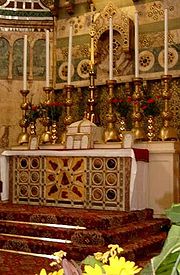
|
Prayer is a vital dimension of fully human living. But
while we can all pray on our own, it is always in some sense a community thing.
It turns us away from ourselves towards God, and in so doing it turns us towards
each other (or should do).
In fact human civilization has always been built
around an act of worship, a public liturgy.
Liturgy (from the Greek leitourgia:
public work or duty) technically means any kind of religious service done on
behalf of a community.
|
Liturgical prayer is a way of being in tune with our
society, with other people. But if we are to renew our civilization by renewing
our worship, we must understand also that liturgy is a way of being in tune with
the motions of the stars, the dance of atomic particles, and the harmony of the
heavens that resembles a great song.
And Catholic liturgy takes us even deeper
than that. It takes us to the source of the cosmos itself, into the sacred
precincts of the Holy Trinity where all things begin and end, whether they know
it or not, and to the source of all artistic and scientific inspiration, of all culture.
|
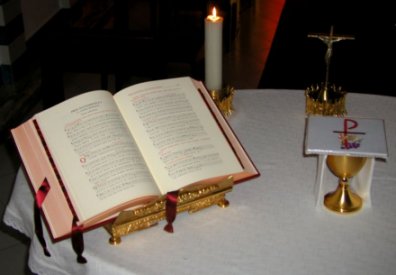
|
|
For in him all the fullness of God was pleased to
dwell,
and through him to reconcile to himself all things, whether on the earth
or in heaven,
making peace by the blood of his cross
(Col. 1:20). |
|
Some
useful links
Ratzinger
at Fontgombault
'Liturgy
and Trinity'
Institute
for Sacred Architecture
New
Liturgical Movement
Antiphon
magazine
|
The
Snowbird Statement
Motu
Propriu: Summorum Pontificum in English
Pope's
letter accompanying Motu Proprio
Adoremus
Hillenbrand
|
The
Oxford
Declaration on Liturgy
The
Centre for Faith & Culture organized an international conference or Forum on
Roman Catholic liturgy in
Oxford
during 1996. Our conclusions were as follows.
1.
Reflecting on the history of liturgical renewal and reform since the Second
Vatican Council, the Liturgy Forum agreed that there have been many positive
results. Among these might be mentioned the introduction of the vernacular, the
opening up of the treasury of the Sacred Scriptures, increased participation in
the liturgy and the enrichment of the process of Christian initiation. However,
the Forum concluded that the preconciliar liturgical movement as well as the
manifest intentions of Sacrosanctum Concilium have in large part been
frustrated by powerful contrary forces, which could be described as
bureaucratic, philistine and secularist.
2. The effect has
been to deprive the Catholic people of much of their liturgical heritage.
Certainly, many ancient traditions of sacred music, art and architecture have
been all but destroyed. Sacrosanctum Concilium gave pride of place to
Gregorian chant [Section 116], yet in many places this "sung theology"
of the Roman liturgy has disappeared without trace. Our liturgical heritage is
not a superficial embellishment of worship but should properly be regarded as
intrinsic to it, as it is also to the process of transmitting the Catholic faith
in education and evangelization. Liturgy cannot be separated from culture; it is
the living font of a Christian civilization and hence has profound ecumenical
significance.
3. The
impoverishment of our liturgy after the Council is a fact not yet sufficiently
admitted or understood, to which the necessary response must be a revival of
the liturgical movement and the initiation of a new cycle of reflection and
reform. The liturgical movement which we represent is concerned with the
enrichment, correction and resacralization of Catholic liturgical practice. It
is concerned with a renewal of liturgical eschatology, cosmology and aesthetics,
and with a recovery of the sense of the sacred – mindful that the law of
worship is the law of belief. This renewal will be aided by a closer and deeper
acquaintance with the liturgical, theological and iconographic traditions of the
Christian East.
4. The revived
liturgical movement calls for the promotion of the Liturgy of the Hours,
celebrated in song as an action of the Church in cathedrals, parishes,
monasteries and families, and of Eucharistic Adoration, already spreading
in many parishes. In this way, the Divine Word and the Presence of Christ's
reality in the Mass may resonate throughout the day, making human culture into a
dwelling place for God. At the heart of the Church in the world we must be able
to find that loving contemplation, that adoring silence, which is the essential
complement to the spoken word of Revelation, and the key to active participation
in the holy mysteries of faith [cf. Orientale Lumen, section 16].
5. We call for a
greater pluralism of Catholic rites and uses, so that all these elements of our
tradition may flourish and be more widely known during the period of reflection
and ressourcement that lies ahead. If the liturgical movement is to
prosper, it must seek to rise above differences of opinion and taste to that
unity which is the Holy Spirit's gift to the Body of Christ. Those who love the
Catholic tradition in its fullness should strive to work together in charity,
bearing each other's burdens in the light of the Holy Spirit, and persevering in
prayer with Mary the Mother of Jesus.
6. We hope that any
future liturgical reform would not be imposed on the faithful but would proceed,
with the utmost caution and sensitivity to the sensus fidelium, from a thorough
understanding of the organic nature of the liturgical traditions of the Church
[cf. Sacrosanctum Concilium, section 23]. Our work should be sustained by
prayer, education and study. This cannot be undertaken in haste, or in anything
other than a serene spirit. No matter what difficulties lie ahead, the glory of
the Paschal Mystery – Christ's love, his cosmic sacrifice and his childlike
trust in the Father – shines through every Catholic liturgy for those who have
eyes to see, and in this undeserved grace we await the return of spring.
In the Declaration, several suggestions were made concerning the future of the
liturgical reform: cultural enrichment, revival of the sense of the sacred and
of contemplative prayer, restoration of plainsong, promotion of the liturgy of
the hours and of eucharistic adoration, and acceptance of a "greater
pluralism of Catholic rites and uses". It stressed the need to avoid any
further mechanical tampering with the liturgy. The implication was that the
liturgy should be permitted to develop organically.
The
Declaration also claimed that a revival of the liturgical movement would be
aided by a "closer and deeper acquaintance with the liturgical, theological
and iconographic traditions of the Christian East". It seems clear
that in many ways the Byzantine tradition has maintained a greater sense of the
sacred and of the cosmic dimensions of the liturgy than the Western tradition
has been able to do. As a consequence, one observes the growing interest in the
Eastern rites on the part of Westerners since the time of the Council.
The
popularity of Byzantine icons in the West is partly a healthy reaction
against the widespread use of sentimentalized devotional images, but as the true
greatness of the iconographic tradition gradually reveals itself lessons may be
learnt concerning the liturgy too: the iconic properties of a ritual which
manifests the action of Christ, compared to the iconic properties of a picture
manifesting his presence, or the reality of his human nature. The point would
not necessarily be to copy the Byzantine rite, but to develop the Roman rite to
a point where the East can recognize in it an authentic Christian liturgy –
which today is often not the case.
Clearly,
further study and reflection are still needed to discern the principles that
should govern any further reform of the liturgy. But a far-reaching programme of
education is also needed, to accompany and make possible a reform of the reform.
What is needed is a continuing education in the language of symbolism, in
the spiritual meaning of the liturgy and of Holy Scripture, in the lives of the
saints, and in the possibility of authentic and orthodox religious experience
– the tradition of the spiritual senses, of contemplative prayer, of ascesis
and purity, of Catholic poetry and sacred art, and of the correct understanding
and value of traditional devotions. The monastic practice of lectio divina has
already become quite popular, but this should be increasingly integrated with a
contemplative lectio of the Mass, and with a developed reflection on the
intimate connection between Scripture and Liturgy.
With
this sole addition of the need for mystagogy, the Oxford Declaration perhaps may
still stand today as an expression of the need felt by many for an authentic
liturgical movement, faithful to the tradition of the Church, and submissive to
the Holy Spirit who fills her with divine life.
|



